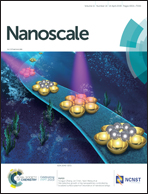Mapping the creep compliance of living cells with scanning ion conductance microscopy reveals a subcellular correlation between stiffness and fluidity†
Abstract
Living cells exhibit complex material properties, which play a crucial role in many aspects of cell function in health and disease, including migration, proliferation, differentiation, and apoptosis. Various techniques exist to probe the viscoelastic material properties of living cells and a frequent observation is a cell-to-cell correlation between average stiffness and fluidity in populations of cells. However, the origin of this correlation is still under discussion. Here, we introduce an imaging technique based on the scanning ion conductance microscope (SICM) to measure the creep compliance of soft samples, which allowed us to generate images of viscoelastic material properties of living cells with high spatial and temporal resolution. We observe a strong subcellular correlation between the local stiffness and fluidity across the individual living cell: stiff regions exhibit lower fluidity while soft regions exhibit higher fluidity. We find that this subcellular correlation is identical to the previously observed cell-to-cell correlation. The subcellular correlation reversibly vanishes after drug-induced disruption of the cytoskeleton, indicating that the subcellular correlation is a property of the intact cytoskeleton of the living cell.



 Please wait while we load your content...
Please wait while we load your content...